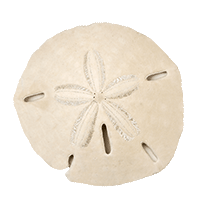Bleach Them First

Sand dollars are commonly found washed up on beaches and are collected like seashells; they are called sand dollars because they resemble currency when the sun bleaches them. The bodies feature a pattern that resembles a flower; they often have five keyhole slits, although some have none at all. You can use sand dollars of all sizes in fun craft projects. Newly collected sand dollars should be soaked in a 50/50 bleach solution to clean them.
Jewelry
The slits in sand dollars make them easy to use for making all types of jewelry. You can use the sand dollars as they are for natural jewelry or paint them with acrylics to make custom pieces. You can paint a completely original design or use the flower etching on the sand dollar as your guide. Personalize the sand dollar with a name, date or your favorite slogan. Slide the sand dollar onto a silver or gold chain to make necklaces and bracelets or try stringing them on jewelry wire with beads to take the project a step further. Purchase earring wires or key rings with chains to make sand dollar earrings and key chains.
Picture Frame
Make a sand dollar picture frame to commemorate your beach trip. Check your local thrift stores for frames with wide edges. The color doesn't matter because you can paint them your choice of color, such as white, blue or sea-green. Once the acrylic paint dries, arrange the sand dollars on the picture frame until you find a pattern that you like and that fits well. Apply glue around the edge of the sand dollars with a hot glue gun and place them on the picture frame. Take care to protect your fingers; the gun gets hot.
Ornaments
Sand dollars can be made into holiday ornaments to decorate your home, whether you live at the beach or want to be reminded of the beach during the cold months. The flower impression on sand dollars makes a great poinsettia template for painted ornaments, but you can paint a variety of winter or holiday themes on a sand dollar. Once the paint dries, push a piece of ribbon through one of the holes, tie a bow and hang it on your Christmas tree, mantle or doorknob. Plain sand dollars could also be glued to a foam ring to make a wreath that breaks the usual holiday tradition.
 Sand dollars are commonly found washed up on beaches and are collected like seashells; they are called sand dollars because they resemble currency when the sun bleaches them. The bodies feature a pattern that resembles a flower; they often have five keyhole slits, although some have none at all. You can use sand dollars of all sizes in fun craft projects. Newly collected sand dollars should be soaked in a 50/50 bleach solution to clean them.
Sand dollars are commonly found washed up on beaches and are collected like seashells; they are called sand dollars because they resemble currency when the sun bleaches them. The bodies feature a pattern that resembles a flower; they often have five keyhole slits, although some have none at all. You can use sand dollars of all sizes in fun craft projects. Newly collected sand dollars should be soaked in a 50/50 bleach solution to clean them.
 Fun Projects With Sand Dollars
Fun Projects With Sand Dollars